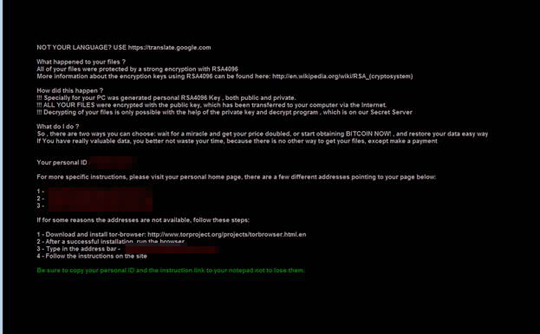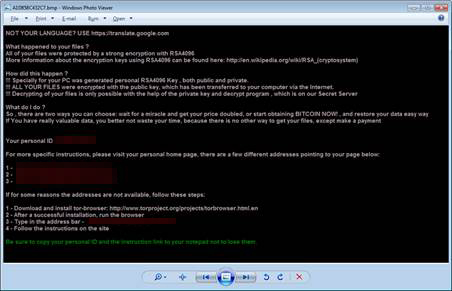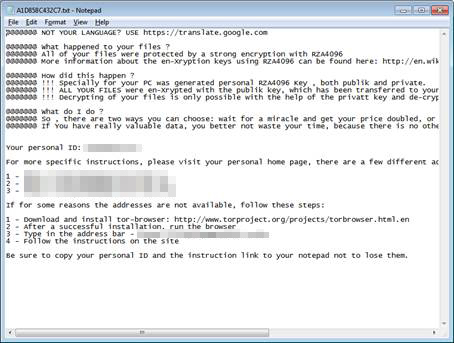RANSOM_WALTRIX
Ransom:Win32/Exxroute (Microsoft), Win32/Filecoder.CryptProjectXXX.C trojan (NOD32)
Windows


Threat Type: Trojan
Destructiveness: No
Encrypted: Yes
In the wild: Yes
OVERVIEW
This ransomware, known as CryptXXX, is a .DLL file that is capable of locking screens. To avoid analysis, it has routines that makes it aware if it is run in a virtual environment. It is being distributed by the Angler Exploit Kit.
This Trojan arrives on a system as a file dropped by other malware or as a file downloaded unknowingly by users when visiting malicious sites.
It terminates itself if it detects it is being run in a virtual environment. It gathers information and reports it to its servers.
TECHNICAL DETAILS
Arrival Details
This Trojan arrives on a system as a file dropped by other malware or as a file downloaded unknowingly by users when visiting malicious sites.
Installation
This Trojan drops the following file(s)/component(s):
- ProgramData\{unique ID}.key
- ProgramData\Z - deleted afterwards. contains installation date of this malware
- {folders containing encrypted files}\{unique ID}.bmp - image used as wallpaper
- {folders containing encrypted files}\{unique ID}.html - ransom note
- {folders containing encrypted files}\{unique ID}.txt - ransom note
where {unique ID} contains 12 hexadecimal characters
It adds the following processes:
- copy of the legitimate rundll32.exe named as:
• %User Temp%\svchost.exe - executes svchost.exe {malware}.dll,MS11{number}
(Note: %User Temp% is the user's temporary folder, where it usually is C:\Documents and Settings\{user name}\Local Settings\Temp on Windows 2000, Windows Server 2003, and Windows XP (32- and 64-bit); C:\Users\{user name}\AppData\Local\Temp on Windows Vista (32- and 64-bit), Windows 7 (32- and 64-bit), Windows 8 (32- and 64-bit), Windows 8.1 (32- and 64-bit), Windows Server 2008, and Windows Server 2012.)
It adds the following mutexes to ensure that only one of its copies runs at any one time:
- {first 5 characters from the unique ID}
Autostart Technique
This Trojan drops the following files:
- %User Startup%\{unique ID}.lnk
(Note: %User Startup% is the current user's Startup folder, which is usually C:\Documents and Settings\{user}\Start Menu\Programs\Startup on Windows 2000 and XP, and C:\Documents and Settings\{User name}\Start Menu\Programs\Startup on Windows Vista, 7, and 8.)
Other System Modifications
This Trojan modifies the following registry entries:
HKEY_CURRENT_USER\Control Panel\Desktop
TileWallpaper = "0"
HKEY_CURRENT_USER\Control Panel\Desktop
Wallpaper = "{random}\{unique ID}.bmp"
Other Details
This Trojan encrypts files with the following extensions:
- .3DM
- .3DS
- .3G2
- .3GP
- .7Z
- .ACCDB
- .AES
- .AI
- .AIF
- .APK
- .APP
- .ARC
- .ASC
- .ASF
- .ASM
- .ASP
- .ASPX
- .ASX
- .AVI
- .BMP
- .BRD
- .BZ2
- .C
- .CER
- .CFG
- .CFM
- .CGI
- .CGM
- .CLASS
- .CMD
- .CPP
- .CRT
- .CS
- .CSR
- .CSS
- .CSV
- .CUE
- .DB
- .DBF
- .DCH
- .DCU
- .DDS
- .DIF
- .DIP
- .DJV
- .DJVU
- .DOC
- .DOCB
- .DOCM
- .DOCX
- .DOT
- .DOTM
- .DOTX
- .DTD
- .DWG
- .DXF
- .EML
- .EPS
- .FDB
- .FLA
- .FLV
- .FRM
- .GADGET
- .GBK
- .GBR
- .GED
- .GIF
- .GPG
- .GPX
- .GZ
- .H
- .H
- .HTM
- .HTML
- .HWP
- .IBD
- .IBOOKS
- .IFF
- .INDD
- .JAR
- .JAVA
- .JKS
- .JPG
- .JS
- .JSP
- .KEY
- .KML
- .KMZ
- .LAY
- .LAY6
- .LDF
- .LUA
- .M
- .M3U
- .M4A
- .M4V
- .MAX
- .MDB
- .MDF
- .MFD
- .MID
- .MKV
- .MML
- .MOV
- .MP3
- .MP4
- .MPA
- .MPG
- .MS11
- .MSI
- .MYD
- .MYI
- .NEF
- .NOTE
- .OBJ
- .ODB
- .ODG
- .ODP
- .ODS
- .ODT
- .OTG
- .OTP
- .OTS
- .OTT
- .P12
- .PAGES
- .PAQ
- .PAS
- .PCT
- .PDB
- .PEM
- .PHP
- .PIF
- .PL
- .PLUGIN
- .PNG
- .POT
- .POTM
- .POTX
- .PPAM
- .PPS
- .PPSM
- .PPSX
- .PPT
- .PPTM
- .PPTX
- .PRF
- .PRIV
- .PRIVAT
- .PS
- .PSD
- .PSPIMAGE
- .PY
- .QCOW2
- .RA
- .RAR
- .RAW
- .RM
- .RSS
- .RTF
- .SCH
- .SDF
- .SH
- .SITX
- .SLDX
- .SLK
- .SLN
- .SQL
- .SQLITE
- .SQLITE
- .SRT
- .STC
- .STD
- .STI
- .STW
- .SVG
- .SWF
- .SXC
- .SXD
- .SXI
- .SXM
- .SXW
- .TAR
- .TBK
- .TEX
- .TGA
- .TGZ
- .THM
- .TIF
- .TIFF
- .TLB
- .TMP
- .TXT
- .UOP
- .UOT
- .VB
- .VBS
- .VCF
- .VCXPRO
- .VDI
- .VMDK
- .VMX
- .VOB
- .WAV
- .WKS
- .WMA
- .WMV
- .WPD
- .WPS
- .WSF
- .XCODEPROJ
- .XHTML
- .XLC
- .XLM
- .XLR
- .XLS
- .XLSB
- .XLSM
- .XLSX
- .XLT
- .XLTM
- .XLTX
- .XLW
- .XML
- .YUV
- .ZIP
- .ZIPX
It renames encrypted files using the following names:
- {original file name.file extension}.crypt
It terminates itself if it detects it is being run in a virtual environment.
It gathers the following information and reports it to its servers:
- It reports infection status and unique ID to {BLOCKED}.{BLOCKED}.13.153
NOTES:
This ransomware locks the screen and displays the following message:



SOLUTION
Step 1
Before doing any scans, Windows XP, Windows Vista, and Windows 7 users must disable System Restore to allow full scanning of their computers.
Step 2
Note that not all files, folders, and registry keys and entries are installed on your computer during this malware's/spyware's/grayware's execution. This may be due to incomplete installation or other operating system conditions. If you do not find the same files/folders/registry information, please proceed to the next step.
Step 3
Restart in Safe Mode
Step 4
Restore this modified registry value
Important: Editing the Windows Registry incorrectly can lead to irreversible system malfunction. Please do this step only if you know how or you can ask assistance from your system administrator. Else, check this Microsoft article first before modifying your computer's registry.
- In HKEY_CURRENT_USER\Control Panel\Desktop
- Wallpaper = "{random}\{unique ID}.bmp"
- Wallpaper = "{random}\{unique ID}.bmp"
- In HKEY_CURRENT_USER\Control Panel\Desktop
- TileWallpaper = "0"
- TileWallpaper = "0"
Step 5
Search and delete this file
- ProgramData\{unique ID}.key
- %User Startup%\{unique ID}.lnk
- {folders containing encrypted files}\{unique ID}.bmp
- {folders containing encrypted files}\{unique ID}.html
- {folders containing encrypted files}\{unique ID}.txt
Step 6
Restart in normal mode and scan your computer with your Trend Micro product for files detected as RANSOM_WALTRIX. If the detected files have already been cleaned, deleted, or quarantined by your Trend Micro product, no further step is required. You may opt to simply delete the quarantined files. Please check this Knowledge Base page for more information.
Step 7
Restore encrypted files from backup.
Did this description help? Tell us how we did.

